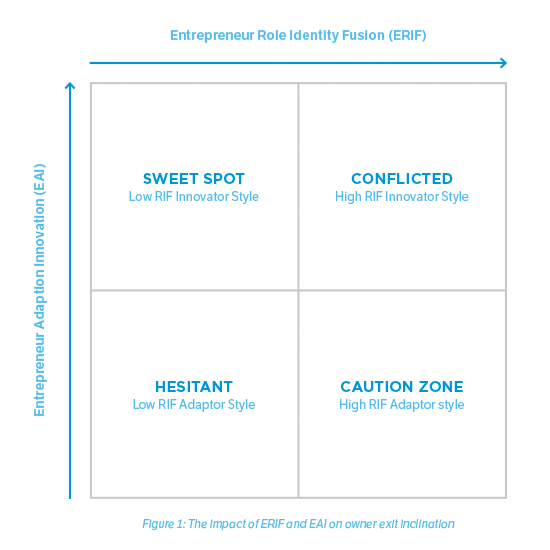
Existing literature on successful CEO/entrepreneurs goes back more than 30 years and it describes five common characteristics:
1. Risk taking propensity
2. Tolerance for ambiguity
3. Need for goal achievement
4. Need for control
5. Innovativeness
Without these characteristics, entrepreneurs would never be able to get out of bed in the morning to push through all of the obstacles and challenges that confront them on the road to success. In fact, only a fraction (some say 10%) of all businesses that are started grow to achieve sufficient market success that owners have the option of a voluntary exit. Yet, less than 30% of all businesses in the mid-market actually sell (West, 2015).
The Innovativeness Characteristic
That draws us to the characteristics of owners and some interesting research that came out of Ohio State University (OSU) in the mid 1970’s on innovativeness.
Entrepreneurs experience innovativeness as both a characteristic and a behavior. As a characteristic innovativeness operates as an enduring personality trait that is stable over time, but as a behavior it may be experienced quite differently. Craig and Ginter (1975) of OSU conceptualized innovativeness as an openness to change construct. Over time other researchers have built on their work and today, Xu & Tuttle (2012) have developed the adaption-innovation at work (AI-W) scale that measures a person’s problem solving style on a continuum.
The continuum ranges from Adaptors who prefer the tried and true, are content with making small improvements, and do not like to go looking for problems that need solving to the Innovators that like to blaze new trails, test creative solutions, and seek out problems that need to be solved. Entrepreneurs that start businesses leverage their innovativeness as a propensity toward creativity and the Innovator behavior as a problem solving style to start and grow their businesses. While the characteristic of innovativeness is enduring, Innovator behavior is more malleable and may change over time.
As entrepreneurs achieve new levels of success they recognize that they cannot blaze new trails in all areas, rather systems and processes are necessary for scale, and they quickly get bored with ground they have covered. This reality contributes to entrepreneurs moving toward an Adaptor style in many areas of the business. Simultaneously, entrepreneurs are partially or wholly satiating motivational needs for competency, relatedness, and autonomy through their role as owner. Entrepreneurs that satiate these needs wholly from their business may begin to experience role-identity fusion (RIF).
Role-Identity Fusion (RIF)
RIF is the concept of an individual, having poor boundaries between their self-identity and their role-identity, may become fused. For highly fused business owners this means that they are their business and their business is them. Thus, the concept of succession or exit planning is not akin to leaving a job. Rather, it is akin to a business owner letting go of a fundamental part of their identity. Thus the question Burlingham (2013) asks in his book Finish Big: How Great Entrepreneurs Exit Their Companies on Top, “Who am I if not my business?”
Now consider how the concepts of RIF and AI might work together to impinge on or enhance and owner’s inclination for exit (Figure 1).

Owners that are:
- In the Sweet Spot can focus on ensuring a robust exploratory phase that answers existential questions of what the owner wants for MOM (Money, Ownership, Management) and themselves in the future beyond the business.
- In the Hesitant Zone don't find identity to be an issue. Instead, these owners may be stuck due to their problem solving style. As Adaptors they are less open to significant change, prefer the status quo, tried and true, and incremental change. Owners in this quadrant will require a more in depth exploratory process that allows them to make new meaning over time and begin to conceptualize their future beyond the business prior to engaging in a strategic planning process.
- In the Conflicted Zone are open to change and have an Innovator problem solving style, but their level of role identity fusion is so high that despite wanting to approach a successful transaction they simply cannot. Advisors are encouraged to ensure owners are provided with resources for engaging identity issues during the exploratory phase prior to engaging in strategic planning and certainly prior to the execution phase.
- In the Caution Zone are likely to have a very difficult time separating from their business. RIF arises from a psychological phenomenon that has (in part) been responsible for helping the owners achieve success. But, RIF can be devastating at the point of exit. Owners should engage skilled experts to help address these issues and advisors are cautioned that these owners will not move quickly, easily, or successfully through a transaction - barring a significant trigger event.
Becoming part of the elite group of entrepreneurs that build successful mid-market businesses and exit on their own terms to live a life of significance and satisfaction requires entrepreneurs to address sometimes significant psychological barriers. Those that do leverage their strengths and avoid the pitfalls of strengths becoming weaknesses that inhibits their ability to exit.
References:
Burlingham, B. (2013). Finish Big: How Great Entrepreneurs Exit Their Companies on Top. Portfolio / Penguin Group, New York, New York.
Craig, C. and Ginter, J. (1975),"An Empirical Test of a Scale For Innovativeness", in NA - Advances in Consumer Research Volume 02, eds. Mary Jane Schlinger, Ann Arbor, MI: Association for Consumer Research, Pages: 555-562
Gomez, A., Brooks, M., Buhrmester, D., Vázquez, A., Jetten, J., & Swann, W., (2011). On the Nature of Identity Fusion: Insights Into the Construct and a New Measure. Journal of Personality and Social Psychology. 100(5) pp 918-933.
West, T. (2015). Business reference guide: The essential guide to pricing businesses and franchises. Wilmington: Business Brokerage Press.
Xu, Y. and Tuttle, B. (2012). Adaption-Innovation at Work: A new Measure of Problem-Solving Styles. JAMAR 10(1).